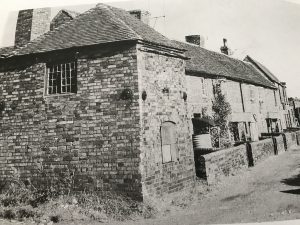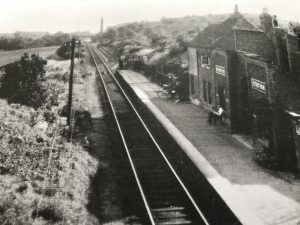Dark Lane Community (Hollinswood and Telford Town Centre)
Research Contributors: Mike Houlston and Melville Rogers

Hollinswood Community and Telford Town Centre overlayed on 1882 Map of Dark Lane by Malcolm Peel
In 1814 brothers Thomas and William Botfield, owners of who The Old Park Company, took out a lease on 72 acres of land and later purchased it. During this time there was sufficient prosperity to develop the land and in 1830 Dark Lane Village was built for the workers of local mines and ironworkers. It was divided east and west by the Wellington to Coalport railway line .This line was built in 1860/61 to serve the community. The passenger steam engine using this line was known by residents as “The Dark Lane Dodger”. Prior to this line being built it was a canal bed and part of the east Shropshire canal system.
The west side had the postal address of Malinslee nr Wellington and the east side Dark Lane nr Shifnal. It is said that if you stood on the centre of the railway bridge you would have one foot in Malinslee and the other in Dark Lane.

There were two rows of cottages in the main part of the village. The long row which ran parallel to the east side of the railway line consisted of 27 cottages. The bottom row had 16 cottages which ran parallel to the Priorslee to Hinksay road. There was also a detached cottage which was situated in the corner between the two rows. On the west side of the Wellington to Coalport railway line was Malinslee Railway Station. Over the road from there was a row of six cottages and a shop / bakery. It was known as Paynes Row. Mr Payne was the owner of the shop. The shop served the whole community.
Small scattered communities on the Malinslee side were socially linked to the main village, they were the Top Farm (Cartwrights), Abbey Villas and The Lodge.
At the east end of the village was the Methodist Chapel and Village Hall which was very much the centre of the community (please see Dark Lane Chapel Heritage Site for more information). Next to the chapel was another railway line known as the Chemical Line which ran from Hollinswood Junction to Randlay Brickworks and on to the Chemical Works at Stirchley.

During the early days of the village the residents were mainly employed in mines and ironworks. Both industries involved hard manual labour. The mines were the most dangerous. Women and children as young as seven worked down the mines until the 1840’s commissioned report on children’s employment.
By the mid 1850s the Botfield Old Park Company group consisting of its original Old Park, Dark Lane, Hinksay, Stirchley and Langley sites were experiencing difficulties. The landlord of the land increased the cost of rental renewal causing the group to be split up and be sold. The new owners soon got into difficulties and in 1877 the Old Park site which in 1810 was the second biggest ironworks in Britain closed down. This caused great poverty and hardship in communities like Dark Lane. Families that stayed in Dark Lane eventually found employment with companies that continued to survive in the area, mainly the Lilleshall Company who continued to expand in mining, iron/steel making and engineering products. Others were employed by new foundries, brick making, steel processing, local authorities and railways.
By the mid 1900s the community experienced much better rates of employment. The village thrived up until the development of Telford and Telford Development Cooperation plans to demolish the whole community.
Today there are still remains left of Dark Lane Community. Two tree’s that are situated on the grass open space leading up to the A442 bridge, the Shrewsbury to Birmingham railway bridge and remains of Dark Lane road wall as you approach Priorslee.

Past & Future Spaces & Places Project with Telford Walkers 2017. One of the two remaining trees from Dark Lane.
There are also past residents and their ancestors living throughout Telford who are able to share their memories of Dark Lane Village and its’ community.
A new community was built in the late 1970’s called Hollinswood. Through research for The Miner’s Walk heritage trail it has become known that a Hollinswood village once existed where the M54 junction 5 is sited today.
Over the coming months this web site will be developed further to include more Dark Lane, Telford Town Centre and Hollinswood heritage sites and memories kindly shared by local residents, groups, Shropshire Archives and Ironbridge Gorge Museum Trust Archives.
Sources:-
- shropshirehistory.com
- Rogers, D and Rogers, M (2002) Dark Lane: the Forgotten Village of Telford
- Shropshire Archives
- The Heritage Lottery Funded Miner’s Walk Memory Recording Events (Greenways Farm St Georges November 2017 and Turnpike Court St Georges January 2018)
- Woolwich, Graham (2010) Dark Lane the forgotten village of Telford; youtube.com
If you would like to contribute to further research on The Miner’s Walk Heritage Trail you would be really welcome. Please get in touch through one of our contact links.
If at all you feel copyright is infringed in any way, shape or form please let us know. We apologise in advance if this is the case and we will amend our write ups and/ or accredit you if permitted. Many thanks!


